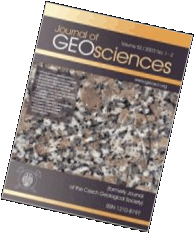 Export to Mendeley
Export to MendeleyOriginal Paper
Formation conditions of calcite veins in the quarry "V Kozle (Hostim I, Alkazar)' in the Bohemian Karst
Journal of the Czech Geological Society, volume 39 (1994), issue 4, 313 - 318
In the quarry “V Kozle” (also called Hostim I., Alkazar) situated on the left bank of the Berounka river in the central part of the Bohemian Karst, Devonian limestones are crosscut by several steeply dipping calcite veins. The largest vein occurs in the NW section of underground galleries, which were excavated here by the German army in 1944-1945 to construct an underground production plant. Later, in the early sixties, part of the underground workings was used as a repository of low-level radioactive waste.
The steeply dipping calcite vein of NNW-SSE direction (160°) reaches maximal thickness of about 1.9 m and is accompanied by zones of brecciation and locally by dolomitization. A 15-cm calcite scalenohedron from a cavity in the central part of the vein was used fora detailed fluid inclusion and stable isotope study.
Based on the data obtained, formation of the studied vein as a result of karstic processes can be excluded. Fluid inclusion data indicate that the central part of the scalenohedron was formed from fluids with temperature above 100 °C. Based on carbon isotope data, formation of the vein during diagenetic processes and derivation of the vein-forming fluids from the limestone sequence itself can be excluded as well. The vein-forming fluids probably originated in deeper parts of the Barrandian sedimentary basin where elastic rocks and volcanites predominate. This idea is supported by local dolomitization of the brecciated zone. Oxygen isotope data indicate that fluids that formed the main calcite accumulation were either deep circulating meteoric waters or pore-waters from deeper sections of the basin. The youngest calcite in the vein filling was deposited from fluids with temper¬atures of up to 60 °C and with very low salinities.
Webdesign inspired by aTeo. Hosted at the server of the Institute of Petrology and Structural Geology, Charles University, Prague.
ISSN: 1803-1943 (online), 1802-6222 (print)
email: jgeosci(at)jgeosci.org


IF (WoS, 2024): 1.3
5 YEAR IF (WoS, 2024): 1.4
Policy: Open Access
ISSN: 1802-6222
E-ISSN: 1803-1943